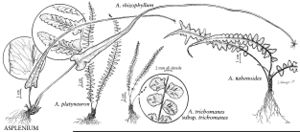Asplenium rhizophyllum
Sp. Pl. 2: 1078. 1753.
Roots not proliferous. Stems erect or ascending, usually unbranched; scales dark brown throughout, narrowly deltate, 2–3 × (0.2–)0.5–1 mm, margins entire. Leaves monomorphic but fertile leaves generally larger than sterile leaves. Petiole reddish brown at base, becoming green distally, dull but sometimes lustrous at base, 0.5–12 cm, 0.1–1.5 times length of blade; indument of dark brown, narrowly deltate scales at base, of minute, club-shaped hairs distally. Blades highly variable in size and shape, even on 1 plant, narrowly deltate to linear-lanceolate, simple, 1–30 × 0.5–5 cm, leathery, sparsely pubescent, hairs more numerous abaxially than adaxially; blade base cordate, auriculate, or occasionally hastate, auricles rarely attenuate and radicant; margins entire to sinuate, rarely irregularly incised; apex rounded to very long-attenuate and, if attenuate, generally rooting at tip. Rachis green, dull, nearly glabrous. Veins obscure, anastomosing to form areoles near midrib. Sori numerous, scattered somewhat irregularly over blade, often joined at vein junctures. Spores 64 per sporangium. 2n = 72.
Habitat: Shaded, usually moss-covered boulders and ledges, usually on limestone or other basic rocks, but occasionally on sandstone or other acidic rocks, rarely on fallen tree trunks
Elevation: 0–1000 m
Distribution

Ont., Que., Ala., Ark., Conn., D.C., Ga., Ill., Ind., Iowa, Kans., Ky., Maine, Md., Mass., Mich., Minn., Miss., Mo., N.H., N.J., N.Y., N.C., Ohio, Okla., Pa., R.I., Tenn., Vt., Va., W.Va., Wis.
Discussion
Asplenium rhizophyllum, a diploid species, is morphologically very distinctive within Asplenium and is segregated by many authors, along with its sister species A. ruprechtii Kurata of eastern Asia, into the genus Camptosorus Link. Proliferations arising from leaf tips result in the formation of clonal patches, often dense and extensive, on the mossy boulders and ledges where it typically grows. Naturally occurring sterile hybrids are known with A. platyneuron (these and their fertile allotetraploid derivatives are both referred to A. ebenoides), A. ruta-muraria (A. × inexpectatum E. L. Braun ex C. V. Morton), A. trichomanes subsp. trichomanes [A. × shawneense (R. C. Moran) H. E. Ballard], and A. ebenoides. In addition, the allotetraploid A. pinnatifidum is derived from the hybrid A. montanum × rhizophyllum; the sterile diploid hybrid is unknown.
Selected References
None.
